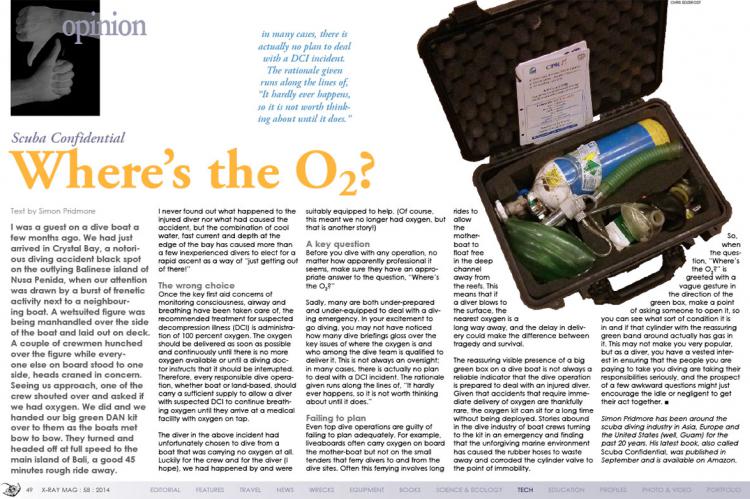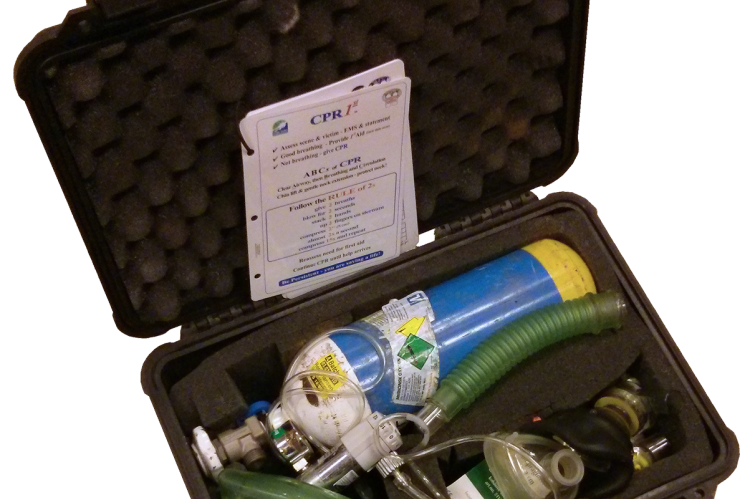Where is the O2?
In many cases, there is actually no plan to deal with a DCI incident. The rationale given runs along the lines of, “It hardly ever happens, so it is not worth thinking about until it does.”
Tags & Taxonomy
I was a guest on a dive boat a few months ago. We had just arrived in Crystal Bay, a notorious diving accident black spot on the outlying Balinese island of Nusa Penida, when our attention was drawn by a burst of frenetic activity next to a neighbouring boat. A wetsuited figure was being manhandled over the side of the boat and laid out on deck. A couple of crewmen hunched over the figure while everyone else on board stood to one side, heads craned in concern. Seeing us approach, one of the crew shouted over and asked if we had oxygen. We did and we handed our big green DAN kit over to them as the boats met bow to bow. They turned and headed off at full speed to the main island of Bali, a good 45 minutes rough ride away.
I never found out what happened to the injured diver nor what had caused the accident, but the combination of cool water, fast current and depth at the edge of the bay has caused more than a few inexperienced divers to elect for a rapid ascent as a way of “just getting out of there!”
The wrong choice
Once the key first aid concerns of monitoring consciousness, airway and breathing have been taken care of, the recommended treatment for suspected decompression illness (DCI) is administration of 100 percent oxygen. The oxygen should be delivered as soon as possible and continuously until there is no more oxygen available or until a diving doctor instructs that it should be interrupted. Therefore, every responsible dive operation, whether boat or land-based, should carry a sufficient supply to allow a diver with suspected DCI to continue breathing oxygen until they arrive at a medical facility with oxygen on tap.
The diver in the above incident had unfortunately chosen to dive from a boat that was carrying no oxygen at all. Luckily for the crew and for the diver (I hope), we had happened by and were suitably equipped to help. (Of course, this meant we no longer had oxygen, but that is another story!)
A key question
Before you dive with any operation, no matter how apparently professional it seems, make sure they have an appropriate answer to the question, “Where’s the O2?”
Sadly, many are both under-prepared and under-equipped to deal with a diving emergency. In your excitement to go diving, you may not have noticed how many dive briefings gloss over the key issues of where the oxygen is and who among the dive team is qualified to deliver it. This is not always an oversight; in many cases, there is actually no plan to deal with a DCI incident. The rationale given runs along the lines of, “It hardly ever happens, so it is not worth thinking about until it does.”
Failing to plan
Even top dive operations are guilty of failing to plan adequately. For example, liveaboards often carry oxygen on board the mother-boat but not on the small tenders that ferry divers to and from the dive sites. Often this ferrying involves long rides to allow the mother-boat to float free in the deep channel away from the reefs. This means that if a diver blows to the surface, the nearest oxygen is a long way away, and the delay in delivery could make the difference between tragedy and survival.
The reassuring visible presence of a big green box on a dive boat is not always a reliable indicator that the dive operation is prepared to deal with an injured diver. Given that accidents that require immediate delivery of oxygen are thankfully rare, the oxygen kit can sit for a long time without being deployed.
Stories abound in the dive industry of boat crews turning to the kit in an emergency and finding that the unforgiving marine environment has caused the rubber hoses to waste away and corroded the cylinder valve to the point of immobility.
So, when the question, “Where’s the O2?” is greeted with a vague gesture in the direction of the green box, make a point of asking someone to open it, so you can see what sort of condition it is in and if that cylinder with the reassuring green band around actually has gas in it.
This may not make you very popular, but as a diver, you have a vested interest in ensuring that the people you are paying to take you diving are taking their responsibilities seriously, and the prospect of a few awkward questions might just encourage the idle or negligent to get their act together. ■
Download the full article ⬇︎

Originally published
X-Ray Mag #58
Cuba's Gardens of the Queen; Indonesia's Bunaken; Solomon Islands' New Georgia; Norway's Frankenwald wreck; Fluorescent Night Diving; Doug Allan profile; Dive Fitness on Back & Biceps; Scuba Confidential on O2; Sharks Close to Extinction; Tech Talk on Exposure; Blu Rivard portfolio; Plus news and discoveries, equipment and training news, books and media, underwater photo and video equipment, turtle news, shark tales, whale tales and much more...



